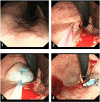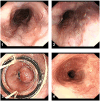Endoscopic variceal ligation combined with sclerotherapy for management of gastroesophageal variceal bleeding in pediatric patients: a single-center retrospective study
- PMID: 39011063
- PMCID: PMC11246951
- DOI: 10.3389/fped.2024.1325419
Endoscopic variceal ligation combined with sclerotherapy for management of gastroesophageal variceal bleeding in pediatric patients: a single-center retrospective study
Abstract
Objectives: Portal hypertension (PH) frequently gives rise to severe and life-threatening complications, including hemorrhage accompanied by the rupture of esophageal and gastric varices. In contrast to the guidelines for the management of PH in adults, the optimal endoscopic management of variceal bleeding for secondary prophylaxis in children remains unclear. The present study evaluated the efficacy and safety of endoscopic variceal ligation (EVL) and endoscopic sclerotherapy (EST) to control gastroesophageal variceal bleeding in children.
Methods: This retrospective study included children with gastroesophageal variceal bleeding who underwent EST or EVL at Xinhua Hospital, Shanghai Jiaotong University School of Medicine, between February 2013 and March 2020. Short-term hemostasis rate and long-term rebleeding rate were evaluated. Adverse events related to the procedures, such as esophageal ulcer, esophageal stricture, abnormal embolization, pneumonia and perforation, were also recorded.
Results: EVL (n = 8) and EST (n = 13) were performed successfully in all pediatric patients diagnosed with moderate to severe esophageal varices concurrent with gastric varices. Hemostasis was achieved during episodes of upper gastrointestinal bleeding. The mean volume of each single aliquot of cyanoacrylate injected was 0.3 ± 0.1 ml (range: 0.1-0.5 ml). Varices were eradicated in six (75%) of the eight patients who underwent EVL after a median 2 (range: 1-4) procedures and a median time of 3.40 months (range: 1.10-13.33 months). Eleven (52.4%) of the 21 patients developed rebleeding events, with the mean duration of hemostasis being 11.1 ± 11.6 months (range 1.0-39.2 months). No treatment-related complications, for example, distal embolism, occurred except for abdominal pain in one patient (4.8%).
Conclusions: EST, alone or in combination with EVL, is an effective and safe method of managing gastroesophageal variceal hemorrhage in children undergoing secondary prophylaxis.
Keywords: endoscopic ligation; endoscopic sclerotherapy; gastroesophageal variceal bleeding; portal hypertension; secondary prophylaxis.
© 2024 Li, Sun, Huai, Qu, Shen, Zhang and Xu.
Conflict of interest statement
The authors declare that the research was conducted in the absence of any commercial or financial relationships that could be construed as a potential conflict of interest.
Figures



References
-
- Maksoud-Filho JG, Gonçalves ME, Cardoso SR, Gibelli NE, Tannuri U. Long-term follow-up of children with extrahepatic portal vein obstruction: impact of an endoscopic sclerotherapy program on bleeding episodes, hepatic function, hypersplenism, and mortality. J Pediatr Surg. (2009) 44(10):1877–83. 10.1016/j.jpedsurg.2009.02.074 - DOI - PubMed
LinkOut - more resources
Full Text Sources
Research Materials

